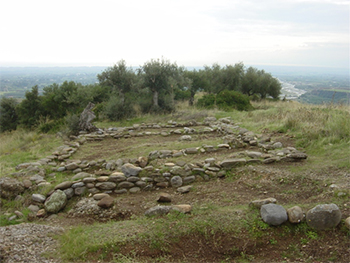Brief research history

Archaeology by the Groningen Institute of Archaeology in northern Calabria combines excavations, landscape surveys and specialist studies of the material culture of the protohistoric site of Timpone della Motta near Francavilla Marittima as well as multidisciplinary landscape archaeological studies of the surrounding foothills and the Raganello valley.
Timpone della Motta is located in the foothills of the coastal plain of the Sibaritide near the Greek colony of Sybaris in northern Calabria. Situated in the heart of Magna Graecia, this site, together with its surroundings, boasts a unique and well-studied archaeological record encompassing elements of daily life, religion and funerary customs that range from the Middle Bronze Age to the Hellenistic period.
Introduction
Research carried out from 1963 to 1967 by P. Zancani Montuoro and M.W. Stoop on the Timpone della Motta led to the discovery of a cult place: five buildings were identified with different constructive phases dating from the VIII cent. to the VI cent. B.C. Subsequent research carried out by the GIA from 1991 onwards led to the discovery of previous indigenous settlement phases, preceding the Greek sanctuary and dating from the Middle Bronze Age to the Early Iron Age.
The goal of the GIA excavation team to place the development of the site of Timpone della Motta in a regional and long term perspective led to the Raganello Archaeological Project (RAP). The RAP officially started in 2000 as part of a larger interdisciplinary project carried out in collaboration with the Free University of Amsterdam and has been continued in subsequent years by the GIA up to this day. During this 15-year period new projects were started under the umbrella of the RAP, bringing to light new field data that provided fresh insights in the pre- and protohistory of the Sibaritide.

A further point of departure for the investigations of the Raganello Archaeological Project was the knowledge of archaeological sites in the Raganello basin gathered by the local Gruppo Speleologico “Sparviere” and the ceramic collections deriving from them. These sites are located west of the Sibari plain, in the territories of present-day S. Lorenzo Bellizzi and Francavilla Marittima, and partly in the territories of Civita and Cerchiara. Other investigations in the territory of Cassano allo Jonio and Frascineto were included in this project.
The results of the GIA multidisciplinary research that involved field walking surveys, material studies, geophysical prospections and excavations, show that Timpone della Motta and other sites located in the hilly area around the Sibari Plain were in use from the Middle Bronze Age to the Early Iron Age. While, the lower slopes of the foothill are characterized by sites that developed in the Late Bronze Age-Early Iron Age, the hinterland appears to be more markedly settled during the Middle Bronze Age. The sites in the foothill are long duration sites, continuously settled without interruptions from the Middle Bronze Age to the Early Iron Age. The hill of Timpone della Motta, unlike the other sites on the hills around the plain is characterized by a proto-urban development during the Iron Age.
In addition to defining the organization and evolution of human occupation in the Sibaritide region, the GIA research project constitutes a pilot study for other South Italian regional contexts.
| Last modified: | 09 May 2017 2.45 p.m. |
